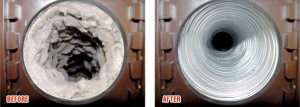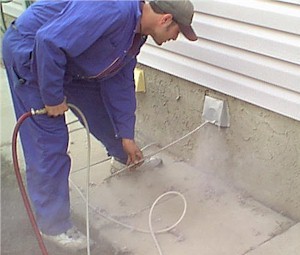Hundreds of fires in Canada are sparked each year by clogged dryer vents.
According to a 2007 report from Canadian Association of Fire Marshals, There are 23,086 structure fires annually in Canada. Dryer fires accounting for 2% of those fires works out to approximately 460 house fires per year are caused by clothes dryers which might seem like a low number until you consider that these fires are largely, highly preventable.
Dryer Overheating
Hot air enters the dryer chamber where your clothes are and moves around in the chamber to get rid of the moisture. Lint, a highly flammable byproduct of the drying process accumulates inside the dryer chamber as the clothes are being tossed around. As the hot air is vented from the dryer, it naturally carries with it the lint. This lint then begins to build up all along the venting system. Over time air flow in the exhaust duct becomes restricted causing the dryer to operate harder and hotter to dry the clothes which in turn causes a short circuit or ignites the lint. The fire then spreads by escaping through the ventilation duct, incinerating trapped lint and following its path into the building wall
Warning signs
The first sign you might have a problem is if your clothes are still wet after a cycle of drying. The dryer is designed to exhaust heat and moisture, if it cannot escape they dryer keeps working but cannot accomplish the drying. We once had a customer whose dryer stopped working for them while simultaneously becoming hot to the touch. During the cleaning process we discovered the homeowner had inadvertently put a disposable diaper in the dryer which after disintegrating released a heavy amount of lint into the duct. We were very happy to have solved this problem for her.
The more laundry you do, the higher risk and more frequent cleaning schedule you’ll need. If your family is large, if you operate a hair salon, laundromat, property management company, hotel, daycare, or other business that regularly operates dryers or if you’re a multiunit strata with shared laundry are all factors that can lead to more frequent cleaning
Some other signs to look for:
• Drying time taking longer than normal
• Musty door is noticed in the clothing following the drying cycle
• Clothing is unusually hot to the touch
• Dryer vent hood flap does not open as it should during operation
• Debris is noticed within the outside vent opening
• Surface of dryer is very hot to the touch
• Excessive heat in laundry room
Cleaning and tips
Most fire departments recommend an annual cleaning service for most single-dwelling residential homes. More often if your usage is significantly higher. Professional cleaning is relatively inexpensive given its benefits at around $150. In addition to the reduced threat of fire, a cleaning can help pay for itself through the improved efficiency with less drying time.
Another advantage to hiring an experienced and reliable professional is that they have likely seen most every type of configuration and can clean your unit more efficiently while making repairs and recommendations to improve the entire system.
One last thing to consider is that most laundry areas are in the mechanical area of your home that includes the furnace and hot water tank. It is a very good idea to keep a fire extinguisher in this area to protect all of these appliances and your home.
– See more at: https://imagineservices.ca/blog/dryer-fires-and-how-to-prevent-them#sthash.lNgjlNf9.dpuf